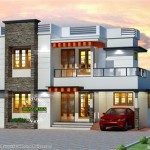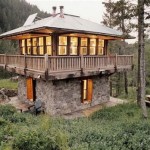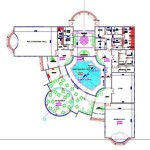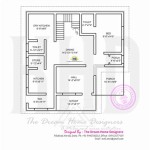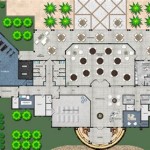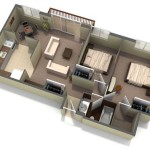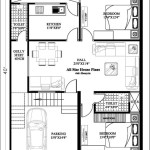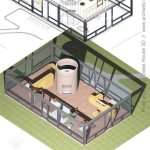Zero Lot Line 2-Story House Plans: Optimizing Space and Design
Zero lot line (ZLL) house plans represent a specific approach to residential construction where a house is built very close to or on one side property line. This type of design is particularly popular in urban and suburban areas where land is at a premium and maximizing buildable space is crucial. Two-story ZLL house plans offer a vertical expansion to further increase living space while navigating the constraints of a smaller footprint. Understanding the nuances of these plans, including their benefits, design considerations, and potential challenges, is essential for anyone considering building or purchasing a ZLL home.
The core concept behind a ZLL development is to utilize the land more efficiently. By placing one side of the house directly on the property line, or very close to it, a larger yard or outdoor living area can be created on the opposite side. This design philosophy is often found in planned communities or areas with specific zoning regulations that encourage innovative land use. The two-story element adds another layer of space optimization, allowing for more bedrooms, bathrooms, or living areas without expanding the ground floor footprint.
ZLL homes and specifically two-story iterations are not without their complexities. Careful planning and adherence to local building codes are paramount. Furthermore, it is important for prospective homeowners to fully understand the long-term implications of living in a ZLL property, particularly concerning maintenance, access, and potential neighborly considerations.
The growing appeal of ZLL homes stems from several factors. Firstly, affordability plays a significant role. By reducing the land requirement, developers can offer homes at a more accessible price point. Secondly, the focus on efficient land use aligns with sustainable development principles, contributing to denser, more walkable communities. Finally, the design flexibility of ZLL plans allows for creative and contemporary architectural styles that appeal to a wide range of homebuyers.
Key Benefits of Zero Lot Line 2-Story House Plans
The advantages of opting for a zero lot line two-story house plan are manifold. These advantages extend beyond sheer square footage and often contribute to a more desirable lifestyle, particularly in densely populated areas.
One of the primary benefits is
Maximized Land Utilization
. In areas where land prices are high, ZLL homes provide a cost-effective solution. By building on or near the property line, the remaining land can be used for a larger yard, patio, or garden. The two-story design further enhances this by doubling the potential living area without increasing the ground-level footprint. This is particularly attractive in urban environments where maximizing outdoor space is highly valued.Another advantage is the potential for
Increased Affordability
. Reducing the land component of the total cost can make homeownership more accessible. While the construction costs may be comparable to a similarly sized home on a larger lot, the reduced land acquisition cost can significantly lower the overall price. This can be a crucial factor for first-time homebuyers or those looking to downsize without sacrificing living space.Finally, ZLL homes often promote a sense of
Community and Connection
. Because ZLL developments tend to be denser, residents often find themselves in closer proximity to their neighbors. This can foster a stronger sense of community and encourage social interaction. Furthermore, the carefully planned layouts of ZLL communities often include shared green spaces and amenities, further enhancing the sense of belonging.Design Considerations for Zero Lot Line 2-Story Houses
Designing a zero lot line two-story house requires careful attention to detail and a thorough understanding of local building codes and regulations. Several key considerations must be addressed to ensure a functional, aesthetically pleasing, and code-compliant home.
Firstly,
Fire Safety
is of paramount importance. Because one side of the house is built on or close to the property line, fire-resistant construction materials and techniques are crucial. This may include using fire-rated walls, windows, and roofing materials on the property-line side of the house. Additionally, firewalls may be required to prevent the spread of fire to neighboring properties. Local building codes will dictate the specific requirements for fire safety in ZLL construction.Secondly,
Access and Maintenance
must be carefully planned. Providing access to the property-line side of the house for maintenance and repairs can be challenging. Easements may be required to allow access from the neighboring property for tasks such as painting, gutter cleaning, or roof repairs. Alternatively, designs may incorporate features that allow for access from the opposite side of the house, such as extending the roof overhang or creating a narrow passageway. Careful consideration must be given to ensuring that maintenance can be performed without encroaching on the neighbor's property.Thirdly,
Privacy and Light
are important considerations. Designing for privacy can be challenging when the house is built close to the property line. Careful placement of windows and the use of landscaping can help to mitigate this issue. Using privacy screens, fences, or strategically planted trees and shrubs can create a buffer between the house and the neighboring property. Similarly, maximizing natural light can be challenging, particularly on the property-line side of the house. Skylights, light wells, and strategically placed windows can help to bring natural light into the interior spaces.Finally,
Stormwater Management
must be addressed. Properly managing stormwater runoff is crucial to prevent water damage to the house and neighboring properties. Gutters, downspouts, and proper grading can help to direct stormwater away from the foundation. In some cases, stormwater detention or retention systems may be required to manage runoff from the property. Local regulations will dictate the specific requirements for stormwater management in ZLL developments.Potential Challenges and Mitigation Strategies
While ZLL homes offer numerous benefits, they also present potential challenges that must be addressed to ensure a positive living experience. Understanding these challenges and implementing appropriate mitigation strategies is crucial for both developers and homeowners.
One common challenge is
Neighborly Relations
. Living in close proximity to neighbors can sometimes lead to disputes over issues such as noise, landscaping, or property line boundaries. Open communication and a willingness to compromise are essential for maintaining positive neighborly relations. Establishing clear expectations regarding noise levels, landscaping maintenance, and property line etiquette can help to prevent conflicts from arising. Participating in community events and getting to know your neighbors can also foster a sense of camaraderie and mutual respect.Another challenge is
Restricted Views and Sunlight
. Because the house is built close to the property line, views may be limited, and sunlight may be blocked by neighboring structures. Careful site planning and architectural design can help to mitigate this issue. Orienting the house to maximize views and sunlight exposure is crucial. Incorporating large windows, skylights, and light wells can help to bring natural light into the interior spaces. Additionally, landscaping can be used to create privacy screens and enhance the views from the windows.Furthermore,
Resale Value
can be a concern for some homeowners. While ZLL homes can be more affordable to purchase initially, their resale value may not be as high as homes on larger lots. This is due to the perceived lack of privacy and outdoor space. However, the resale value of ZLL homes can be enhanced by features such as well-maintained landscaping, updated interiors, and desirable location. Focusing on curb appeal and highlighting the benefits of ZLL living, such as lower maintenance and community amenities, can also help to attract buyers.Finally,
Adherence to Strict Regulations
is often necessary. ZLL developments are typically subject to strict zoning regulations and building codes. These regulations may dictate the size, height, and setback of the house, as well as the types of materials that can be used in construction. Developers and homeowners must be fully aware of these regulations and ensure that their plans comply with all applicable requirements. Failure to comply with these regulations can result in costly delays and fines.In summary, the design and construction of a zero lot line two-story house require careful planning and attention to detail. By understanding the benefits, design considerations, and potential challenges associated with this type of housing, developers and homeowners can create functional, aesthetically pleasing, and sustainable living spaces that maximize land utilization and promote a sense of community.

Zero Lot Line Designs

Zero Lot Line Designs

House Plan The Cortez Offers Zero Lot Line Options

Plan 034h 0159 The House

Zero Lot Line Starter Mediterranean Style House Plan 36571tx Architectural Designs Plans

Zero Lot Line Designs

3 Bed European Style Home Plan Perfect For A Zero Lot Line Or Narrow 36656tx Architectural Designs House Plans

Vincent Kabel

Zero Lot Line House Auckland Design Manual

Great Small House Plans Affordable Zero Lot Line Home Efficient Simple Floor

